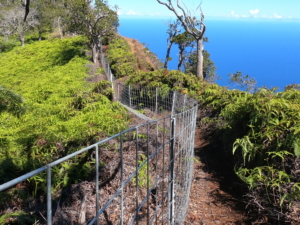 Two fences, one predator proof and the other ungulate proof, are currently under construction in the Nā Pali-Kona Forest Reserve and adjacent Kōke’e State Park. Much of the funding for the project is coming from the Department of Defense’s Readiness Environmental Protection Integration (REPI) program. The funding is the first in the nation for what is considered a non-mitigation project.
Two fences, one predator proof and the other ungulate proof, are currently under construction in the Nā Pali-Kona Forest Reserve and adjacent Kōke’e State Park. Much of the funding for the project is coming from the Department of Defense’s Readiness Environmental Protection Integration (REPI) program. The funding is the first in the nation for what is considered a non-mitigation project.
Sheri S. Mann, the Kaua‘i Branch Manager of the DLNR Division of Forestry and Wildlife (DOFAW) explained that the impetus for the DOD funding was to protect endangered seabirds on Kaua‘i. DOFAW is managing the project for the DLNR Division of State Parks as well.
It involves not only seabird protection, but also protection for numerous endangered plants that make up the reserve’s mesic forest, and important habitat for endangered seabirds, which is the one of the few places on Kaua‘i where this specific habitat occurs.
Mann commented, “This represents the alignment of goals across a long list of agencies, which is the best way to accomplish landscape level conservation. This project will also be the first in Hawai‘i that has a predator proof fence inside of an ungulate proof fence. We hope to prove that while predator proof fences are best for seabird protection, the addition of ungulate proof fences with ongoing predator control, also accomplishes seabird protection.”
Walking some of the completed 4 ½ foot-high ungulate fencing on Kalepa Ridge, DOFAW botanist Adam Williams explains that on nearby Honopu Ridge an additional four-feet of mesh will be added to keep deer out. Ungulate fencing is meant to keep deer, pigs, and goats out. “The eight-foot-high fencing will keep deer out of the entire upper watershed,” Williams said.
Three acres of the 240 acres is also getting predator-proof fending. Williams said, “It is a totally different design, is very small mesh, with a shiny hood to keep cats, rats and mice away from the seabirds.” This will create a safe haven for birds to nest and raise their young until they fledge or leave their nests. Once completed, conservationists will place artificial nests in the enclosure and pay recordings of birds to attract them.
Helen Raine of the Archipelago Research and Conservation (ARC) will be setting up the social attraction part of the project, which means playing seabird calls to attract the more of them inside of the fence. She said, “This will create a sanctuary for them to breed. The artificial burrows provide ready-made homes so they don’t have to dig them with their beaks and feet, which can take years. We’re looking forward to seeing this area become a thriving colony for ‘a’o, ‘ua’u and ‘ake’ake once again.”
In addition to birds, conservation fencing in general helps protect rare and endangered plants. Yuki Reiss, a DOFAW/Pacific Cooperative Studies Unit at UH Water Resource Analyst said, “The same predators that are threats to seabirds are also threats to plants. They tear up the native habitat, eat seeds and cause a lot of erosion. Stopping them improves the ability of native plants to propagate and spread naturally.”
Mann concluded, “DOD provided the biggest share of the funding, but the State has contributed a lot General Funds, staff time and technical resources to this project This is truly a collaborative effort.”
Participants in the Honopu Restoration Project are the DOD, DLNR/DOFAW and DLNR Division of State Parks, the National Fish and Wildlife Foundation, Hallux Ecosystem Restoration LLC, Archipelago Research and Conservation and Pacific Rim Conservation. So far DOD has contributed nearly $1.3 million to the project and DLNR/DOFAW another $300-500K.
Please see below for some interesting aerial footage of Honopu Forest Reserve and a more details on the fencing for the Honopu Restoration Project.


 Daniel Dennison, State of Hawaii
Daniel Dennison, State of Hawaii